- Clone
- 31G4D8 (See other available formats)
- Regulatory Status
- RUO
- Other Names
- Lymphotoxin beta receptor, Tumor necrosis factor receptor superfamily member 3
- Isotype
- Mouse IgG2b, κ
- Ave. Rating
- Submit a Review
- Product Citations
- publications
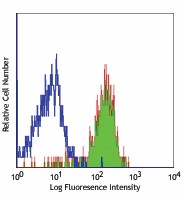
-

Human peripheral blood monocytes stained with Ultra-LEAF™ purified 31G4D8, followed by biotinylated anti-mouse IgG and Sav-PE
| Cat # | Size | Price | Quantity Check Availability | Save | ||
|---|---|---|---|---|---|---|
| 322011 | 100 µg | 216€ | ||||
| 322012 | 1 mg | 542€ | ||||
LT-βR, also known as lymphotoxin beta receptor and tumor necrosis factor receptor superfamily member 3 is a 47 kD transmembrane protein containing 3 TNF receptor domains. The LT-βR is a receptor for the heterotrimeric lymphotoxin complex (composed of LTα and LTβ as well as LIGHT). LT-βR is highly expressed in the lung, liver, and kidney and moderately expressed expressed in the heart and testes. LT-βR is weakly expressed in the brain, thymus, spleen, and lymph nodes. The cytoplasmic tail of LT-βR interacts with TRAF3, TRAF4, and TRAF5 as well as the hepatitis C virus core protein. Ligand binding to LT-βR has been shown to induce apoptosis (via TRAF3 and TRAF5) and play a role in the development of lymphoid organs. The 31G4D8 antibody has been shown to be useful for flow cytometry, Western blot, immunoprepicitation and and ELISA (detection antibody). In addition, the 31G4D8 antibody is an agonistic antibody for the LT-βR capable of inducing apoptosis (with IFN-γ treatment).
Product DetailsProduct Details
- Verified Reactivity
- Human
- Reported Reactivity
- African Green, Cynomolgus, Rhesus
- Antibody Type
- Monoclonal
- Host Species
- Mouse
- Immunogen
- Human LT-βR Fc protein
- Formulation
- 0.2 µm filtered in phosphate-buffered solution, pH 7.2, containing no preservative.
- Endotoxin Level
- Less than 0.01 EU/µg of the protein (< 0.001 ng/µg of the protein) as determined by the LAL test.
- Preparation
- The Ultra-LEAF™ (Low Endotoxin, Azide-Free) antibody was purified by affinity chromatography.
- Concentration
- The antibody is bottled at the concentration indicated on the vial, typically between 2 mg/mL and 3 mg/mL. Older lots may have also been bottled at 1 mg/mL. To obtain lot-specific concentration and expiration, please enter the lot number in our Certificate of Analysis online tool.
- Storage & Handling
- The antibody solution should be stored undiluted between 2°C and 8°C. This Ultra-LEAF™ solution contains no preservative; handle under aseptic conditions.
- Application
-
FC - Quality tested
WB, IP, Apop - Reported in the literature, not verified in house - Recommended Usage
-
Each lot of this antibody is quality control tested by immunofluorescent staining with flow cytometric analysis. For flow cytometric staining, the suggested use of this reagent is ≤ 2.0 µg per million cells in 100 µL volume. It is recommended that the reagent be titrated for optimal performance for each application.
- Application Notes
-
Additional reported applications (for the relevant formats) include: Western blotting1, immunoprecipitation1, ELISA detection1, induction of apoptosis2. The biotinylated 31G4D8 antibody is useful as a detection antibody for a sandwich ELISA assay, when used in conjunction with the purified 36G9G3 antibody (Cat. No. 322101/322102) as capture antibody. The LEAF™ purified antibody (Endotoxin <0.1 EU/µg, Azide-Free, 0.2 µm filtered) is recommended for functional assays (Cat. No. 322003/322004).
-
Application References
(PubMed link indicates BioLegend citation) -
- Developer's communication
- Chen M-C, et al. 2003. J. Biol. Chem. 278:16073.
- RRID
-
AB_2832630 (BioLegend Cat. No. 322011)
AB_2832631 (BioLegend Cat. No. 322012)
Antigen Details
- Structure
- Member of the TNF receptor superfamily; transmembrane receptor containing 3 TNF receptor domains, predicted molecular weight approximately 47 kD
- Distribution
-
Highly expressed in lung, liver, and kidney. Moderate expression in heart and testes; weak expression in brain, thymus, spleen, and lymph nodes.
- Function
- Promotes apoptosis via TRAF3 and TRAF5, plays a role in the development of lymphoid organs
- Interaction
- Receptor for heterotrimeric lymphotoxin complex (composed of LTα and LTβ as well as LIGHT. Also interacts with TRAF3, TRAF4, and TRAF5 as well as hepatitis C virus core protein
- Cell Type
- Embryonic Stem Cells
- Biology Area
- Immunology, Stem Cells
- Molecular Family
- Cytokine/Chemokine Receptors
- Antigen References
-
- Crowe PD, et al. 1994 Science 264:707.
- Gene ID
- 4055 View all products for this Gene ID
- UniProt
- View information about LT-betaR on UniProt.org
Related Pages & Pathways
Pages
Related FAQs
- Do you guarantee that your antibodies are totally pathogen free?
-
BioLegend does not test for pathogens in-house aside from the GoInVivo™ product line. However, upon request, this can be tested on a custom basis with an outside, independent laboratory.
- Does BioLegend test each Ultra-LEAF™ antibody by functional assay?
-
No, BioLegend does not test Ultra-LEAF™ antibodies by functional assays unless otherwise indicated. Due to the possible complexities and variations of uses of biofunctional antibodies in different assays and because of the large product portfolio, BioLegend does not currently perform functional assays as a routine QC for the antibodies. However, we do provide references in which the antibodies were used for functional assays and we do perform QC to verify the specificity and quality of the antibody based on our strict specification criteria.
- Does BioLegend test each Ultra-LEAF™ antibody for potential pathogens?
-
No, BioLegend does not test for pathogens in-house unless otherwise indicated. However, we can recommend an outside vendor to perform this testing as needed.
- Have you tested this Ultra-LEAF™ antibody for in vivo or in vitro applications?
-
We don't test our antibodies for in vivo or in vitro applications unless otherwise indicated. Depending on the product, the TDS may describe literature supporting usage of a particular product for bioassay. It may be best to further consult the literature to find clone specific information.
Other Formats
View All LT-βR Reagents Request Custom Conjugation| Description | Clone | Applications |
|---|---|---|
| Purified anti-human Lymphotoxin beta receptor (LT-βR) | 31G4D8 | FC,IP,WB |
| PE anti-human Lymphotoxin beta receptor (LT-βR) | 31G4D8 | FC |
| Ultra-LEAF™ Purified anti-human Lymphotoxin β Receptor (LT-βR) | 31G4D8 | FC,WB,IP,Apop |
| TotalSeq™-C0932 anti-human Lymphotoxin β Receptor (LT-βR) | 31G4D8 | PG |
Customers Also Purchased
Compare Data Across All Formats
This data display is provided for general comparisons between formats.
Your actual data may vary due to variations in samples, target cells, instruments and their settings, staining conditions, and other factors.
If you need assistance with selecting the best format contact our expert technical support team.
-
Purified anti-human Lymphotoxin beta receptor (LT-βR)
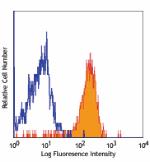
Human peripheral blood monocytes stained with purified 31G4D... -
PE anti-human Lymphotoxin beta receptor (LT-βR)

Human peripheral blood monocytes stained with 31G4D8 PE -
Ultra-LEAF™ Purified anti-human Lymphotoxin β Receptor (LT-βR)
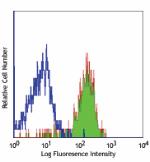
Human peripheral blood monocytes stained with Ultra-LEAF™ pu... -
TotalSeq™-C0932 anti-human Lymphotoxin β Receptor (LT-βR)
 Login / Register
Login / Register 






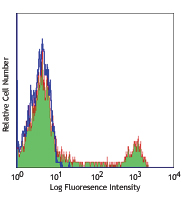
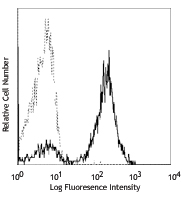




Follow Us